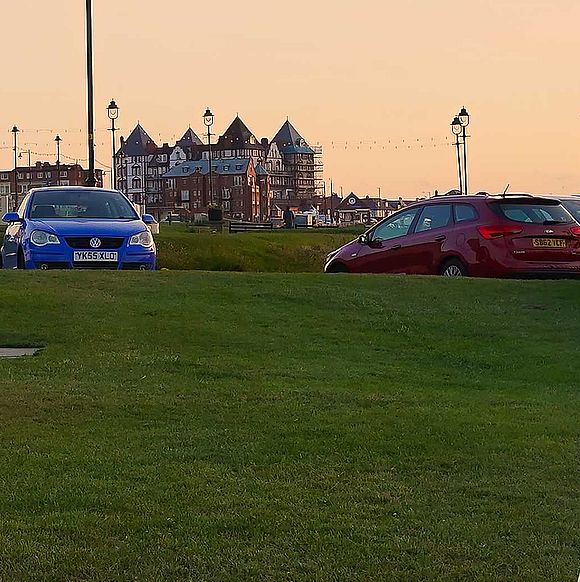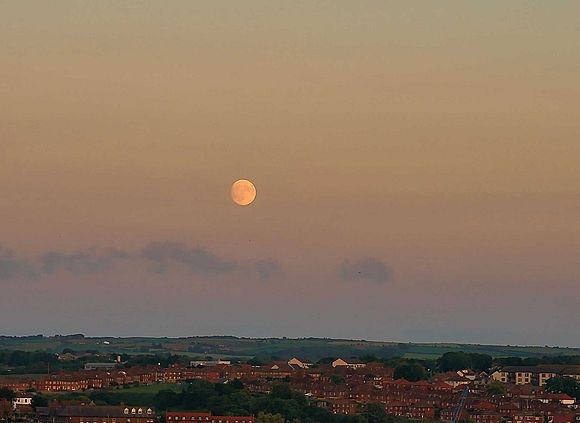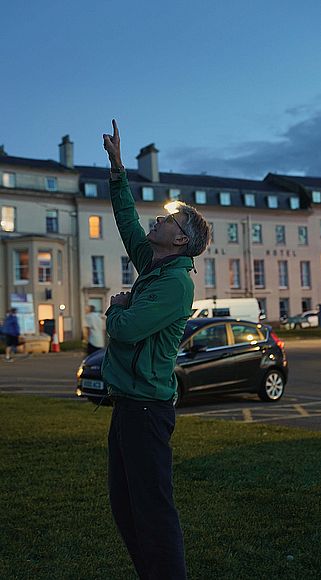Conditions for the star party of July 1st were both better, and worse, than for the event the week before, bizarre, but true. Sky conditions were wonderfully clear, hardly a cloud to be seen, but the temperature was decidedly in the non-heat-wave category, tempered by an on-shore breeze. Not surprisingly, public footfall on the West Cliff was well down compared to a week earlier.
Setting up in the late evening Sun, Tal 4", 6"dob and 10" dob. Image - Keith D
(Click for full image)
The advertising placard had been out from late afternoon, but clear skies or not, a breeze and cooler conditions do seem to deter people from loitering on the West Cliff. That said, a few who were there from the outset did loiter for most of the event. Mark had brought three instruments - the Tal 4" refractor and the 10" and 6" dobsonian’s, but only the 10" was deployed. John Lamb brought his 90mm ETX refractor, Keith his camera.
Skies were almost completely clear, just a little fragmented cloud close to the horizon slowly drifting east and northwards. The setting Sun drew only a few photographers (Keith being one) going down without fanfare. For a while the Moon's location was a mystery, hidden in the strip of cloud low in the SE, or behind the land and buildings on the east side? An almost Full Moon is hard to misplace, and yet initially that was the case. The errant Moon then appeared, pale in the bright twilight, breaking free from its cloudy prison.
Lunar detail was somewhat washed out, the Moon nearing full, but the extensive lunar ray system was evident as too were bright surface features such as the crater Aristarchus. Those stepping up to the eyepiece still marvelled at the view. Attention then turned to locating Venus, which was quickly tracked down in the bright twilight glare to the west. The diminutive crescent phase pleasing in the eyepiece and a surprise for those not familiar with the orbital mechanics of Venus. As skies darkened the first true stars emerged, the usual suspects leading the way. Vega, Arcturus, and Altair were all pointed out. Then Capella and Deneb, the Plough stars, Polaris, and part of Cassiopeia. By 23:00hrs we decided to call it a night, just a few people remaining until the end.
The event on July 29th promised much, skies were forecast to be clear, conditions were pleasant, a persistent breeze present throughout the day having subsided somewhat. Keith and Mark were on the West Cliff by 20:45hrs scrutinising the sky as the Sun dropped into a cloud bank present in the west. To the north, high in west, SW, NE, and overhead skies were quite clear, but varying amounts of cloud obscured the rest of the sky. The plan had been to observe the 10-day old Moon, then brighter emerging stars and finally, Saturn returning to the evening sky. The Moon was not apparent, hidden by cloud low to the south. Still too light for stars to be visible we decided to wait before unloading any equipment.
The Moon, or parts of it, was only fleetingly visible, but more worryingly a large cloud in the SW appeared to be slowly coming our way eating into the clearer skies. The Moon suddenly broke free, but only briefly, cloud was building to the south and we made the decision to put away the placard. Arcturus and Vega became visible, but it was clear the cloud was going to win out and as the time approached 22:00hrs we called it a night and departed. A frustrating affair it had been, bad timing on the cloud front, you win some you lose some. Skies did eventually clear, but not until after 23:00hrs.
- Log in to post comments






